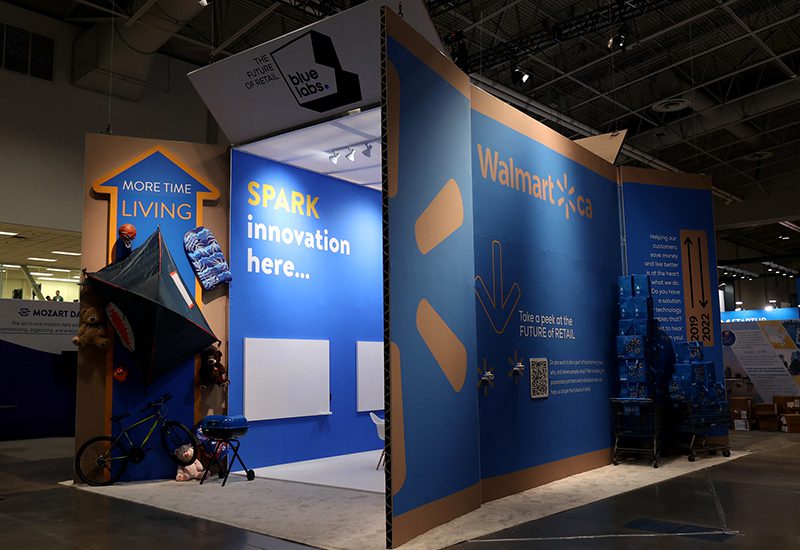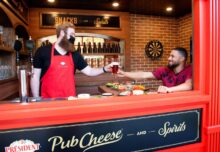For 10 consecutive months, Lee Jeyes, head of innovation at Walmart Canada, was in “stealth mode” working on the brand’s first-ever incubator, Blue Labs. The think tank was ultimately unveiled amid Walmart Canada’s debut at the 2022 Collision conference in Toronto (Kubik handled), where an interactive booth and multiple presentations delivered by executives during the event resulted in an all-around win for the brand and its new enterprise.
We sat down with Jeyes (who also serves as head of innovation at Blue Labs), to get his perspective on experiential tech and innovation in retail, collaborating with startups, supporting employees and approaching business challenges with a “customer lens.”
Event Marketer: Why was it important for Walmart Canada to have a presence at a technology show like Collision?
Lee Jeyes: One [reason] was to continue to share the story around Walmart and the amount of innovation we’re doing. Unfortunately, it’s not something that we get a lot of exposure for. And [Collision] was a great platform for us to share the story of how we continue to be a company on the forefront of innovation. Even if you think back to retail over the last 60 years, Walmart’s always been one of the retailers that has been innovating even from the start, building a supercenter concept, a membership model, expanding online grocery.
We also launched a tech hub in Toronto, where we’re going to be hiring over 3,000 roles, and I launched Walmart Canada’s first-ever innovation incubator, Blue Labs, at the event.
Then the third thing was, we had over 120 associates go to the event just to give them the opportunity to look from an outside-in perspective of: What else is happening outside of Walmart? What are other companies thinking about from an innovation perspective?
 More on Innovation in Retail:
More on Innovation in Retail:
- Why Walmart Canada Dropped a Supersized Version of a Shipping Box at Collision
- Soma Helps Women Solve Their ‘Bra-blems’ at its Pop-up Innovation Lab
EM: What was your approach to the booth design and engagements?
LJ: We were very intentional in how we designed the space so that 35,000-plus people, if they chose, had the opportunity to work with us and ideate. So we created a booth called Thinking Outside the Box. It was intentional on the big Walmart shipping box design with both ends open. And we ran daily innovation challenges with the community there. We had whiteboards up and sticky notes breaking down real, meaningful business problems and challenges. Because although you may not know Walmart, you know retail. Everyone’s a customer at some point. So it’s looking at it from a customer lens.
EM: Did any of the exhibit touchpoints stand out for you?
LJ: We had a QR code you could scan if you were a vendor or a startup with a solution that you potentially wanted to test-pilot in Walmart. We engaged with over 1,300 people throughout the event where they submitted their applications to the organization to potentially work with us. So it wasn’t just about being there to tell our story, but to welcome people into big Walmart and potentially give them the opportunity to partner with us on ideas or solutions they may have.
EM: Tell us about the role Blue Labs plays in Walmart Canada’s ecosystem.
LJ: One of the challenges that I’ve experienced, even in an earlier role, is that the way you work with early-stage organizations has to be very different. How do you take big Walmart, the scale of 2.5 million customers a day in stores and online, and 100,000-plus associates, and now partner with someone that may just have an early stage idea and a smaller team? So it’s being that connected bridge to help incubate their technology or innovation so that it’s ready to be tested and scaled in a larger organization. Because the further out the innovation, the less mature it is, the more that relationship needs to be much more about co-creating, co-designing. Blue Labs is also looking at much longer-tail innovation. I call it ‘disruptive and radical innovation,’ which is a three- to five-plus-year-out journey.
EM: How has the brand’s broader retail strategy evolved over the years?
LJ: I’ve been with the company for 16 years and it’s continuously changing. I often say to my team, ‘Retail is the team sport and the rules of the game are determined by the customer.’ So every single time the game is changed by customers, and their expectations and requirements change, our role is to make sure we’re listening—really listening—and evolving the business to be able to support that. So it’s staying really close to what the customer needs, as well as our associates, because they ultimately play the most important role in the organization in delivering the business model to consumers.
EM: Speaking of employees, how do you ensure they feel heard and supported?
LJ: In the early stages of COVID, everything was moving at such a pace that things were happening in minutes and hours, not days and weeks. So the team and I opened a livestream chat to all of our stores across the chain where any associate manager could dial in and share an idea or a solution to what we were trying to solve. Whether that was one-way aisles in retail stores, whether that was putting Plexiglas up or removing the transaction between the customer and a cashier handing over the receipt—I didn’t think of any of those ideas. They all came from our stores. So really listening to the front line of your business and truly understanding how they think about solving the problem plays an important role.
EM: Is it safe to say the Collision strategy was a success?
LJ: All in all, it was a really good first event for us, a lot of good engagement from the ecosystem. I know my own team and the 100-plus associates that came were really excited about what they were seeing and going back to the business with a fresh perspective.
Photo credit: Carlos Osorio/Collision






